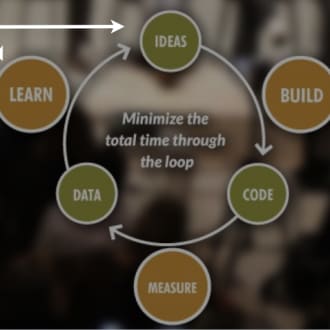
10+ Best Articles on MVP
The most useful articles on MVP from around the web, curated by thought leaders and our community.
Refind focuses on timeless pieces and updates the list whenever new, must-read articles or videos are discovered.
Top 5 MVP Articles
At a glance: these are the articles that have been most read, shared, and saved on MVP by Refind users in 2024 so far.
How to ...?
How to Build a Minimum Lovable Product (MLP)
What isthe difference between an MVP and an MLP product. If you're looking to build a minimum lovable product (MLP) check this out.
«A good way of focusing on desired outcomes is to use Teresa Torres’ Opportunity Solution Tree, from the continuous discovery framework.»
How to Plan an MVP
YC CEO and Partner Michael Seibel shares his approach to building an MVP and getting your first users as a pre-launch startup.
Short Articles
Short on time? Check out these useful short articles on MVP—all under 10 minutes.
Reducing Product Risk and Removing the MVP Mindset
I originally wrote this piece internally at Eventbrite and thought it might be valuable to folks who do not work at Eventbrite as well. Slightly edited to remove Eventbrite jargon.What is the righ
«As Henry Ford allegedly said, “If I’d asked customers what they wanted, they would have said a faster horse.” »
You either die an MVP or live long enough to build content moderation
Learn how to build an automated content moderation workflow with Mux Video and Hive.ai (including an open source example)
«Oh yeah, it’s great. We had to spend the majority of last week trying to come up with clever ways to block users from abusing our platform by uploading NSFW content.»
I hate MVPs. So do your customers. Make it SLC instead.
Product teams have been repeating the MVP (Minimum Viable Product) mantra for a decade now, without re-evaluating whether it’s the right way to maximize learning while pleasing the customer. …
Build an MVP, Not a Beta
A lot of people misuse the term “MVP” or Minimum Viable Product. To be clear an MVP is not a beta, not a prototype, but rather an…
A Better Alternative to MVP Product Development
If you’ve been in the technology space for some time, you’ve almost certainly heard the term “minimum viable product” (MVP). It’s become so…
Long Articles
These are some of the most-read long-form articles on MVP.
The Minimum Viable Testing Process for Evaluating Startup Ideas
The traditional approach is to do some customer research, throw an MVP out there as fast as possible, and hope it hits. After being early at three startups that achieved over $1M in run-rate in their…
«In an MVP, you try to simulate the entire car. In an MVT, you are just testing whether the drivetrain is more powerful with an electric engine or a gas one.»
So long MVP. Hello Minimum Loveable Product. — The Happy Startup School — Medium
Tactics on how to get your digital ideas to market sooner, but still deliver a product that users fall in love with
Crisp's Blog » Making sense of MVP (Minimum Viable Product)
Shared by 170, including bouiboui, Leslie D, Mark Kaigwa, Rand Fishkin, Michael Duergner
Don’t Start With an MVP
It’s been a little over 18 months since Steve quit his day job and ventured out on his own. Even though, his savings ran out 6 months ago…
What is Refind?
Every day Refind picks the most relevant links from around the web for you. Picking only a handful of links means focusing on what’s relevant and useful.
How does Refind curate?
It’s a mix of human and algorithmic curation, following a number of steps:
- We monitor 10k+ sources and 1k+ thought leaders on hundreds of topics—publications, blogs, news sites, newsletters, Substack, Medium, Twitter, etc.
- In addition, our users save links from around the web using our Save buttons and our extensions.
- Our algorithm processes 100k+ new links every day and uses external signals to find the most relevant ones, focusing on timeless pieces.
- Our community of active users gets the most relevant links every day, tailored to their interests. They provide feedback via implicit and explicit signals: open, read, listen, share, mark as read, read later, «More/less like this», etc.
- Our algorithm uses these internal signals to refine the selection.
- In addition, we have expert curators who manually curate niche topics.
The result: lists of the best and most useful articles on hundreds of topics.
How does Refind detect «timeless» pieces?
We focus on pieces with long shelf-lives—not news. We determine «timelessness» via a number of metrics, for example, the consumption pattern of links over time.
How many sources does Refind monitor?
We monitor 10k+ content sources on hundreds of topics—publications, blogs, news sites, newsletters, Substack, Medium, Twitter, etc.
Can I submit a link?
Indirectly, by using Refind and saving links from outside (e.g., via our extensions).
How can I report a problem?
When you’re logged-in, you can flag any link via the «More» (...) menu. You can also report problems via email to hello@refind.com
Who uses Refind?
450k+ smart people start their day with Refind. To learn something new. To get inspired. To move forward. Our apps have a 4.9/5 rating.
Is Refind free?
Yes, it’s free!
How can I sign up?
Head over to our homepage and sign up by email or with your Twitter or Google account.
Keep Learning
Get the big picture on your favorite topics.











